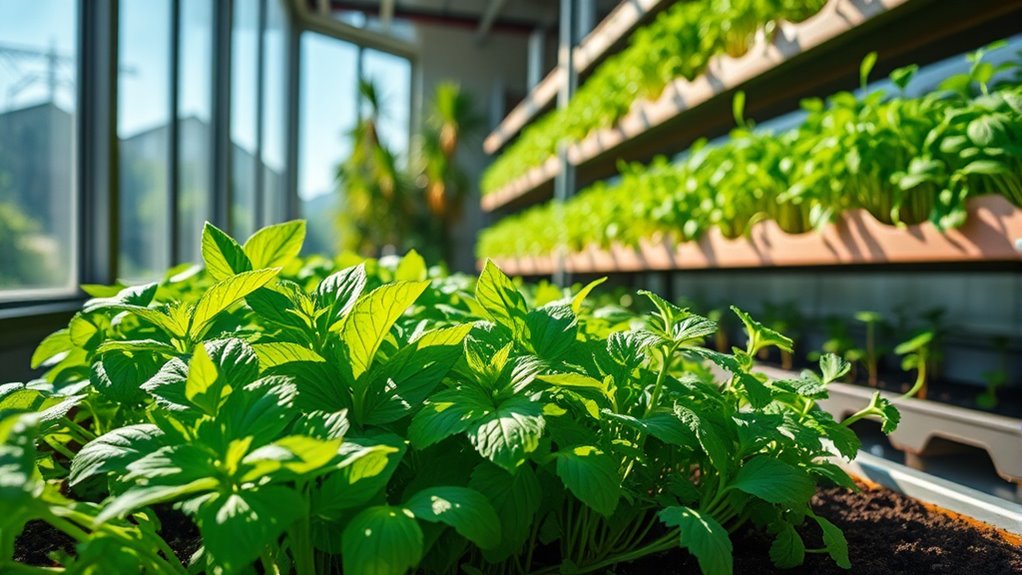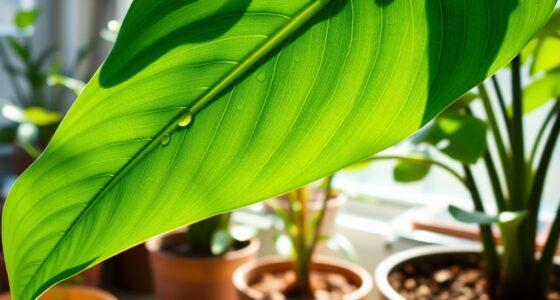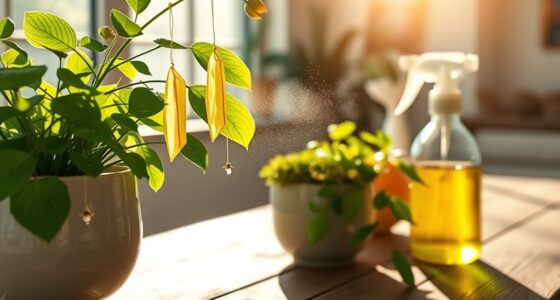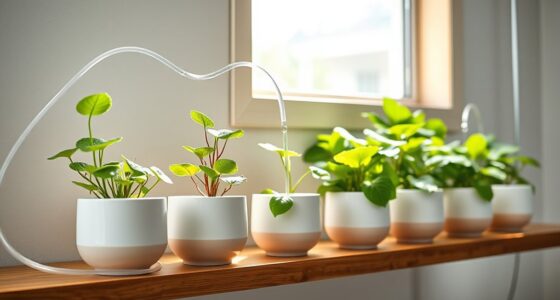Indoor farming changes the taste of plants by precisely controlling factors like light, temperature, and nutrients. By optimizing conditions, you can enhance flavor and nutritional profiles. Hydroponics plays a key role, allowing for tailored nutrient delivery and moisture management that concentrates flavor compounds. Plus, using pesticide-free practices improves taste while benefiting health. If you’re curious about how different elements like light and genetics further contribute to flavor enhancement, there’s much more to explore.
Key Takeaways
- Controlled environmental factors like light, temperature, and humidity can enhance flavor-active compounds in indoor farming.
- Hydroponics allows precise nutrient management, which can fine-tune flavor profiles and improve taste quality.
- Tailored light spectra optimize phytochemical production, directly influencing the taste and aroma of crops.
- Genetic modification and selective breeding can enhance desirable flavor traits, resulting in tastier produce.
- Pesticide-free methods improve flavor by reducing chemical residues and promoting healthier plant growth.
Controlled Environmental Factors and Their Impact on Flavor

When you grow plants indoors, the controlled environmental factors play a crucial role in shaping their flavor.
Light conditions are vital; different wavelengths, like UV and PAR, boost flavor-active molecules. Temperature control ensures optimal growth, influencing the metabolic pathways that create flavor compounds. Maintaining humidity levels reduces stress on your plants, promoting the production of phytochemicals that enhance flavor. Elevated CO2 concentration can improve nutritional quality, increasing sugar and antioxidants, which impact taste. Additionally, tailoring nutrient solutions directly regulates secondary metabolite production, allowing you to fine-tune the flavor profile of your crops. Furthermore, the use of controlled environment techniques allows for consistent year-round cultivation, leading to a more reliable flavor experience. By implementing energy-efficient models, you can optimize the conditions for indoor farming while reducing operational costs. Moreover, creative practices in indoor farming can lead to innovative approaches that further enhance plant flavor through experimentation and adaptation. Incorporating backyard greenhouses can also provide additional growing space and further enhance your indoor farming results.
The Role of Hydroponics in Flavor Development

Hydroponics takes flavor development to another level by allowing growers to fine-tune every aspect of nutrient delivery and environmental conditions. You can select specific cultivars with the best genetic potential for flavor, then precisely control nutrient levels to enhance taste. By inducing slight stress, like moisture stress or adjusting pH, you can concentrate flavor compounds, making your plants taste even better. Hydroponics also ensures efficient nutrient uptake, allowing your plants to grow rapidly while maximizing flavor. With a controlled environment, you can optimize light and temperature, leading to consistent flavor profiles. Additionally, using a water filtration system can help ensure that plants receive clean and safe water, further enhancing their flavor. Incorporating essential oils into hydroponic systems can also improve plant health and flavor development. Furthermore, implementing effective ventilation systems can promote healthier growing conditions, ultimately leading to enhanced flavor profiles. Ultimately, hydroponics provides a sustainable way to grow flavorful produce while minimizing environmental impact. The careful selection of specific cultivars with desirable genetics can significantly improve the final flavor profile of your hydroponic plants.
Benefits of Pesticide-Free and Fresh Produce
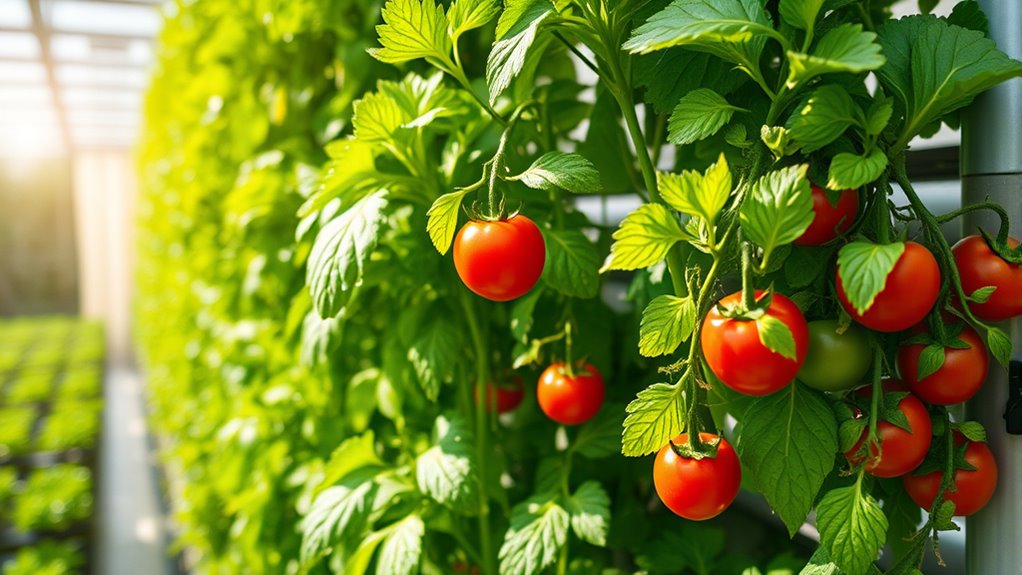
While many consumers seek out fresh produce for its taste and health benefits, opting for pesticide-free options can elevate these advantages even further.
You’ll find that pesticide-free produce typically has reduced chemical residues, enhancing both flavor and health. These plants often absorb nutrients more effectively, leading to improved taste and higher nutritional value. Additionally, organic farming methods can increase higher levels of antioxidants, which contribute to better taste and longer shelf life. By supporting pesticide-free farming, you’re also promoting soil health, which influences flavor profiles. Furthermore, the use of crop rotation can help maintain soil fertility, further enhancing the flavor of the produce. Incorporating raw food principles can also lead to fresher and more flavorful ingredients, as they emphasize unprocessed, nutrient-dense options. Moreover, these pesticide-free methods can lead to the growth of plants with higher fiber content, which can enhance the overall taste experience.
Plus, many people simply prefer the taste of pesticide-free produce, giving you a market advantage. Choosing fresh, pesticide-free items not only benefits your palate but also supports sustainable agriculture practices.
Genetic Modification and Selective Breeding for Taste
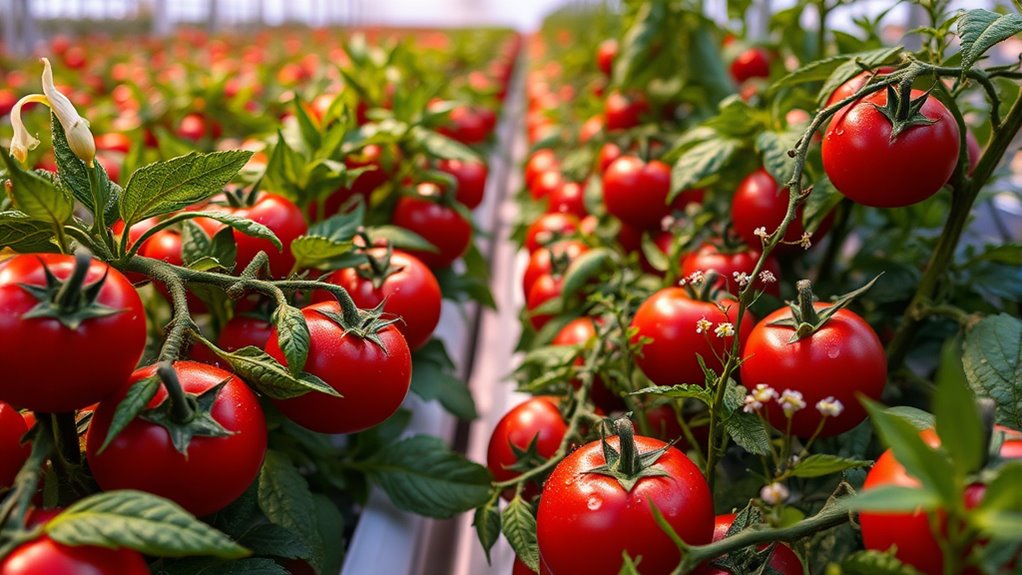
Genetic modification and selective breeding are changing how we approach plant taste, allowing growers to enhance flavor profiles in ways traditional methods can’t.
With tools like CRISPR-Cas9, you can precisely alter traits to boost flavor compounds, reduce bitterness, or increase sweetness in crops. While regulatory challenges limit market availability, gene editing is often utilized in non-commercial lines to pinpoint genes before traditional breeding methods are applied. Additionally, innovative planter designs like unique and wicked planters can create optimal growing conditions that further enhance plant flavor.
CRISPR-Cas9 allows precise flavor enhancements in crops, overcoming regulatory hurdles to improve taste profiles through gene editing.
Selective breeding, especially for indoor environments, prioritizes consumer preferences, focusing on aroma and texture. This approach enables year-round production of flavorful crops while improving growth rates. Controlled Environment Agriculture allows for new breeding opportunities, emphasizing traits that enhance taste and nutrition. Additionally, incorporating antioxidants like quercetin can further improve the health benefits and flavor of these crops. Moreover, advancements in solar energy solutions can support the energy needs of indoor farms, making them more sustainable.
Although trade-offs between traits pose challenges, the future holds potential for crops with better taste and nutritional profiles, provided consumers embrace these innovations.
Influence of Light Spectrum on Phytochemical Production
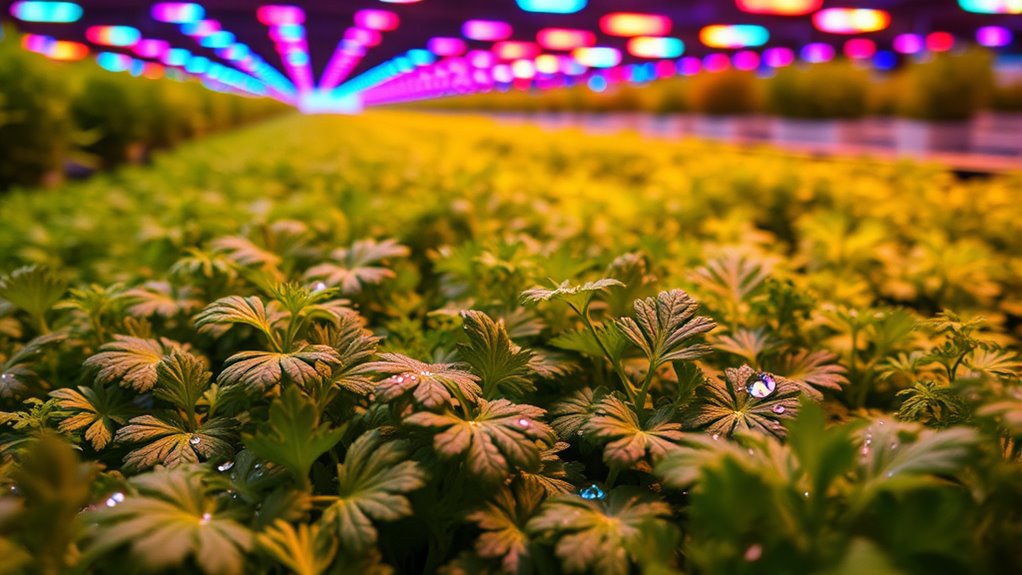
As you delve into indoor farming, understanding the influence of light spectrum on phytochemical production becomes essential for maximizing plant flavor and nutritional value.
Specific light wavelengths can significantly enhance the production of phytochemicals, which contribute to both taste and nutrition. For instance, high blue light levels boost phytochemical content but might limit vegetative growth. In contrast, red light promotes growth but doesn’t enhance phytochemicals as effectively. By employing variable lighting strategies, you can optimize phytochemical biosynthesis at different growth stages. Furthermore, controlled environment agriculture (CEA) systems allow for precise adjustments in light conditions, further enhancing the desired attributes of crops. Additionally, incorporating nutrient-rich ingredients can further improve the overall flavor profile of the plants grown indoors. Regularly monitoring hydration levels is also essential for maintaining the quality of the plants.
Understanding the impact of color accuracy is also vital in indoor farming, as it can affect the overall quality of light and, consequently, the plants’ development.
Finding the right combinations of light is vital for balancing growth and flavor. Tailoring light recipes to specific plants ensures you achieve consistent taste and quality, enhancing consumer acceptance of your indoor-grown produce.
Frequently Asked Questions
How Does Indoor Farming Affect the Nutritional Content of Plants?
Indoor farming significantly boosts the nutritional content of plants.
You’ll experience the benefits of precise control over growing conditions, ensuring optimal nutrient delivery and enhanced plant health.
By using hydroponics, you can maximize yields while reducing the need for pesticides, leading to cleaner produce.
Moreover, customized lighting can increase phytochemical production, enhancing both nutrition and flavor.
With year-round production, you’ll enjoy consistently nutritious crops, regardless of seasonal changes.
Are There Specific Crops That Taste Better When Grown Indoors?
Ever wondered if certain crops taste better when grown indoors?
You’ll find that basil, tomatoes, and herbs often thrive in controlled environments, enhancing their flavors significantly. Indoor conditions allow for precise light and nutrient management, leading to intense tastes.
Lettuce and strawberries can also benefit, providing freshness year-round. While some flavors might lack the complexity of outdoor-grown plants, many indoor crops showcase delightful, consistent flavors you might just love!
What Are the Environmental Impacts of Indoor Farming on Flavor?
Indoor farming significantly impacts flavor by controlling environmental factors like light and nutrients.
You’ll notice that consistent conditions can enhance plant flavors, while reducing pesticide use benefits both taste and health.
However, achieving optimal flavor requires replicating outdoor stressors that boost phytochemical production.
Additionally, localized production means fresher produce, which often tastes better.
How Do Consumer Preferences Influence Indoor Farming Practices?
Consumer preferences are like a compass, guiding indoor farming practices toward what you truly desire.
If you crave quality and freshness, farmers will adapt their techniques to meet those standards, ensuring each bite bursts with flavor.
When price matters to you, they’ll find ways to balance cost without sacrificing quality.
Your values, whether for sustainability or convenience, shape the very fabric of indoor agriculture, making it a responsive and dynamic industry.
Can Indoor Farming Techniques Be Applied to Traditional Agriculture?
You can definitely apply indoor farming techniques to traditional agriculture.
By adopting methods like precision irrigation and climate control, you’ll enhance crop resilience and optimize resource use.
Integrating hydroponic systems for specific crops can boost yields while reducing soil erosion.
Even data-driven approaches can improve management and productivity.
Embracing sustainable practices, like reducing pesticide use, not only benefits your crops but also aligns with growing consumer demands for healthier, environmentally-friendly produce.
Conclusion
Indoor farming is revolutionizing how we experience taste. By controlling environmental factors, you can enhance flavor profiles and boost nutritional content. With hydroponics, you’re growing pesticide-free produce that’s fresher than ever before. Genetic modification and selective breeding open doors to tastier varieties, while the right light spectrum stimulates phytochemical production. Embrace the future of farming, where you enjoy vibrant flavors, relish in freshness, and savor the benefits of innovation—all from the comfort of your own home.

